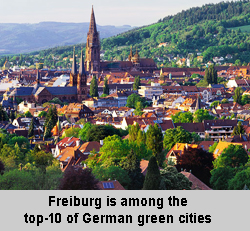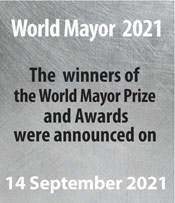The best Mayors for Stronger | Fairer | Greener cities. Elect your candidate for the 20/21 World Mayor Prize and Honours
FRONT PAGE
About us
 
ON OTHER PAGES
Green buildings USA
Germany's greenest cities
German mayors and their salaries
|
|
 Green spaces dominate Green spaces dominate
Germany’s largest cities
November 2017: Almost 70 per cent of the land areas of Germany’s largest cities is taken up by green spaces. Added together, the urban areas of all of Germany cities with more than 100,000 people total 13,564 square kilometres, equivalent to the size of Montenegro, while their green spaces amount to 9,457 sq km, an area roughly the size of Cyprus. University cities like Siegen, Göttingen, Aachen and Freiburg are among the top 10. Green spaces include parks, woodland and agricultural land within city borders and also private gardens.
With green spaces making up 86 per cent of its urban area, Siegen, in North-Rhine Westphalia, is the ‘greenest’ German city. Ludwigshafen, home to BASF, the world’s largest chemical company, is the least green of Germany’s 79 Großstädte, cities with more than 100,000 inhabitants. There are 17 cities where green spaces make up 80 per cent or more of their land areas. The list of 17 includes cities like Aachen, Freiburg, Saarbrücken and Münster. The German capital Berlin is placed 63rd in the overall table, while Hamburg, Cologne and Munich are ranked 39th, 65th and 74th respectively.
Germany’s greenest cities
|
Rank
|
City
Großstädte with more than 100,000 inhabitants
|
Total area
in sq km (1)
|
Green spaces
in sq km
|
Green spaces
% of total area (2)
|
|
1
|
Siegen |
115
|
99
|
86%
|
|
2
|
Göttingen |
117
|
99
|
85%
|
|
3
|
Bergisch Gladbach |
83
|
70
|
84%
|
|
4
|
Salzgitter |
224
|
188
|
84%
|
|
5
|
Pforzheim |
98
|
82
|
83%
|
|
6
|
Aachen |
161
|
133
|
82%
|
|
7
|
Hildesheim |
93
|
76
|
82%
|
|
8
|
Freiburg |
153
|
125
|
82%
|
|
9
|
Hagen |
160
|
130
|
81%
|
|
10
|
Saarbrücken |
167
|
136
|
81%
|
|
11
|
Bielefeld |
258
|
209
|
81%
|
|
12
|
Münster |
303
|
245
|
81%
|
|
13
|
Paderborn |
179
|
143
|
80%
|
|
14
|
Hamm |
226
|
181
|
80%
|
|
15
|
Jena |
114
|
91
|
80%
|
|
16
|
Remscheid |
75
|
60
|
80%
|
|
17
|
Reutlingen |
87
|
69
|
80%
|
|
18
|
Trier |
117
|
92
|
79%
|
|
19
|
Wolfsburg |
204
|
161
|
79%
|
|
20
|
Rostock |
181
|
143
|
79%
|
|
21
|
Chemnitz |
221
|
174
|
79%
|
|
22
|
Solingen |
90
|
71
|
79%
|
|
23
|
Lübeck |
214
|
167
|
78%
|
|
24
|
Wiesbaden |
204
|
159
|
78%
|
|
25
|
Wuppertal |
168
|
130
|
78%
|
|
26
|
Ulm |
119
|
92
|
77%
|
|
27
|
Kassel |
107
|
81
|
75%
|
|
28
|
Braunschweig |
192
|
144
|
75%
|
|
29
|
Mönchengladbach |
170
|
125
|
74%
|
|
30
|
Oldenburg |
103
|
76
|
74%
|
|
31
|
Bottrop |
101
|
74
|
73%
|
|
32
|
Koblenz |
105
|
76
|
73%
|
|
33
|
Mülheim/Ruhr |
91
|
66
|
73%
|
|
34
|
Bonn |
141
|
102
|
72%
|
|
35
|
Darmstadt |
122
|
88
|
72%
|
|
36
|
Heidelberg |
109
|
79
|
72%
|
|
37
|
Ingolstadt |
133
|
95
|
72%
|
|
38
|
Augsburg |
147
|
105
|
72%
|
|
39
|
Hamburg |
755
|
539
|
71%
|
|
40
|
Kiel |
119
|
85
|
71%
|
|
41
|
Heilbronn |
100
|
71
|
71%
|
|
42
|
Reckinghausen |
66
|
47
|
71%
|
|
43
|
Dortmund |
281
|
199
|
71%
|
|
44
|
Osnabrück |
120
|
85
|
71%
|
|
45
|
Stuttgart |
207
|
145
|
70%
|
|
46
|
Bochum |
146
|
101
|
69%
|
|
47
|
Dresden |
328
|
228
|
69%
|
|
48
|
Würzburg |
88
|
61
|
69%
|
|
49
|
Potsdam |
188
|
130
|
69%
|
|
50
|
Krefeld |
138
|
95
|
69%
|
|
51
|
Bremen |
325
|
222
|
68%
|
|
52
|
Essen |
210
|
143
|
68%
|
|
53
|
Moers |
68
|
45
|
66%
|
|
54
|
Hannover |
204
|
133
|
65%
|
|
55
|
Offenbach |
45
|
29
|
65%
|
|
56
|
Karlsruhe |
173
|
111
|
64%
|
|
57
|
Gelsenkirchen |
105
|
67
|
64%
|
|
58
|
Mainz |
98
|
62
|
64%
|
|
59
|
Leverkusen |
79
|
50
|
64%
|
|
60
|
Bremerhaven |
94
|
58
|
62%
|
|
61
|
Neuss |
100
|
61
|
61%
|
|
62
|
Erlangen |
77
|
46
|
60%
|
|
63
|
Berlin |
892
|
526
|
59%
|
|
64
|
Oberhausen |
77
|
45
|
59%
|
|
65
|
Cologne |
405
|
237
|
58%
|
|
66
|
Herne |
51
|
30
|
58%
|
|
67
|
Frankfurt/Main |
248
|
144
|
58%
|
|
68
|
Duisburg |
233
|
132
|
57%
|
|
69
|
Düsseldorf |
217
|
123
|
57%
|
|
70
|
Magdeburg |
201
|
109
|
54%
|
|
71
|
Erfurt |
269
|
143
|
53%
|
|
72
|
Regensburg |
81
|
43
|
53%
|
|
73
|
Fürth |
63
|
33
|
52%
|
|
74
|
Munich |
310
|
155
|
50%
|
|
75
|
Halle |
135
|
66
|
49%
|
|
76
|
Nürnberg |
186
|
89
|
48%
|
|
77
|
Mannheim |
145
|
64
|
44%
|
|
78
|
Leipzig |
297
|
126
|
42%
|
|
79
|
Ludwigshafen |
78
|
27
|
35%
|
|
|
TOTAL / AVERAGE |
13,564 sq km
|
9,457 sq km
|
69%
|
Sources and research methodology:
(1) The research used the size of urban areas provided by municipal websites as well as relevant Wikipedia pages.
(2) The green spaces research was carried out by the Berliner Morgenpost using 185 satellite images.
© Copyright: City Mayors. All rights reserved
|




 Green spaces dominate
Green spaces dominate